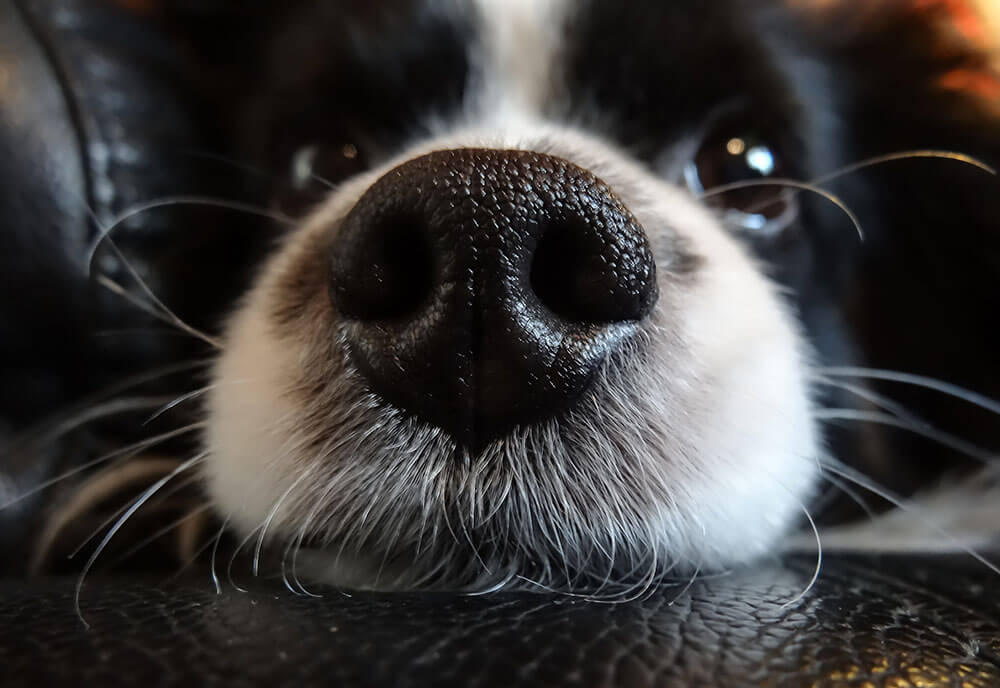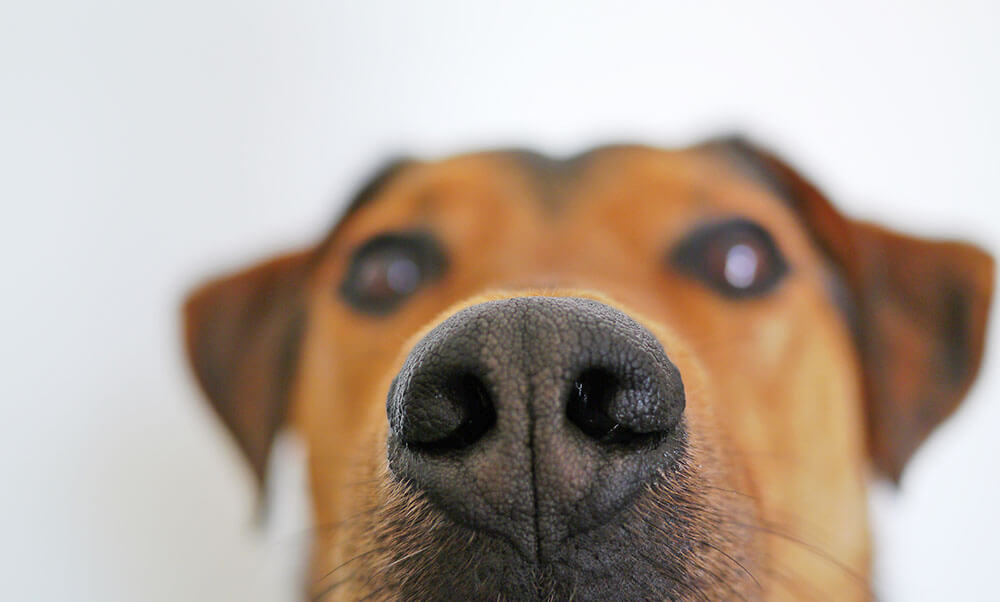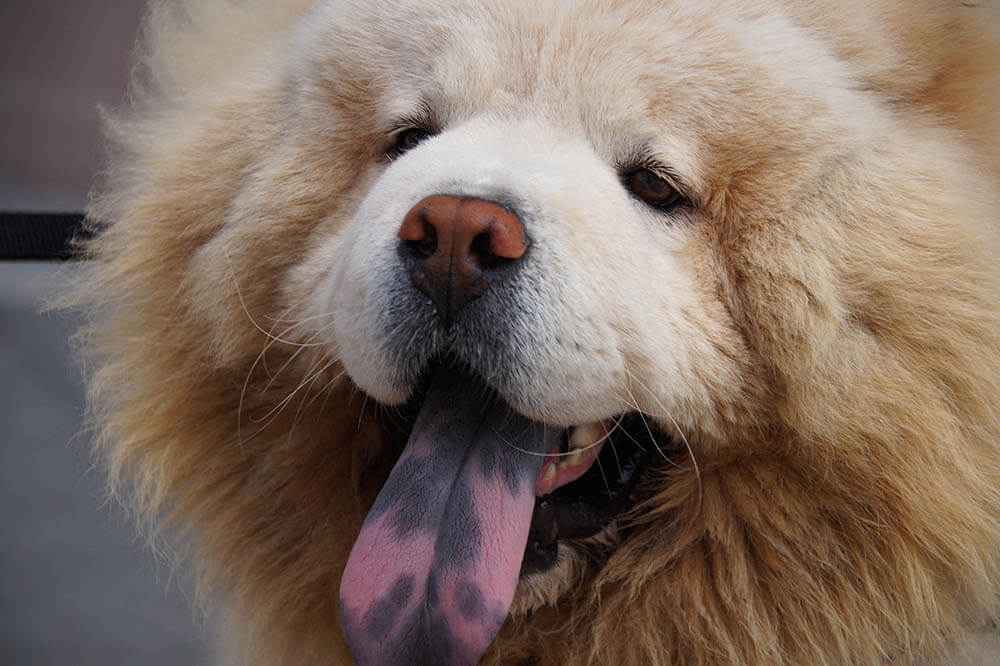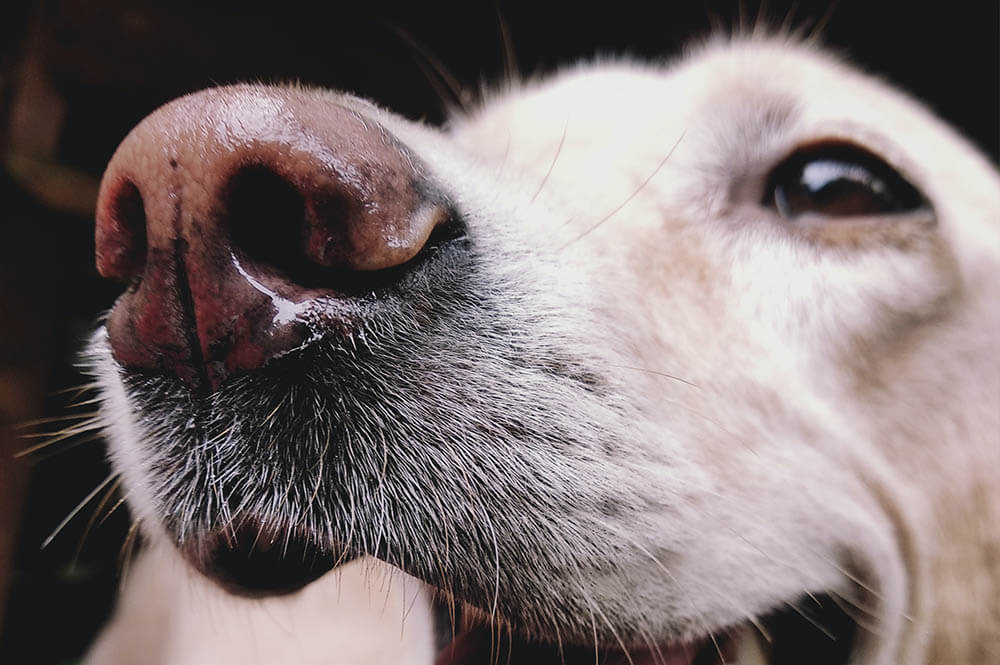When cuddling with your dog, there’s nothing more heart-warming than a cold, wet nose against your cheek.
But have you ever wondered, “Why is my dog’s nose cold and wet?” If so, read on!

Why Dog Noses are Cold and Wet
Contrary to popular belief, dogs don’t have inherently cold, moist noses. Try touching your dog’s nose while they’re sleeping – you’ll find it dry and warm.
So why does your dog’s nose become cold and wet when they’re awake?
Dogs lick their nose
Dogs lick their nose while they’re awake, which ensures the nose is coated with a thin layer of salivary mucus. Meanwhile, as the mucus evaporates, it loses heat energy to the surroundings, cooling the dog’s nose in the process.
Dog olfactory glands produce mucus
The canine nose has special glands that secrete mucus. Every time a dog licks their nose, their tongue spreads a thin film of this mucus over the nose. The mucus can keep your dog’s snout wet and cool for long periods.

The Benefits of Cold, Wet Noses
So your dog is responsible for keeping their nose moist and cool. But what’s the point of cold, wet noses, in the first place?
The answers may surprise you!
Sniffing power enhancement
When it comes to sniffing power, wet noses work better than dry noses.
A wet nose boosts your dog’s sense of smell. Compared to a dry surface, a moist nose catches scent particles out of the air more readily (scent particles stick more easily to damp surfaces). So when a dog’s nose is wet, they can pick up a lot more fascinating odors from the environment.
When your dog licks their nose, these scent chemicals enter their mouth. A scent gland known as the vomeronasal organ a.k.a. Jacobson’s organ (located inside your dog’s mouth) then analyzes these particles, giving your pooch a wealth of important information about their surroundings.
Heat detection
It’s possible cool, wet noses allow dogs to detect weak heat sources in the environment.
In one study, researchers discovered that dogs can sense slightly warm objects around five feet away. In another that employed MRI scans, dog brains were found to respond to warm objects positioned before them.
Because this ability can point where heat is coming from in an environment, it may be useful when a dog is hunting for warm prey. One study even discovered that the noses of carnivores are cooler than those of herbivorous animals, which lends credence to this theory.
Body temperature regulation
Unlike humans, dogs don’t sweat through their skin. Therefore, healthy dogs regulate their body temperature and prevent overheating by panting and sweating through their paw pads.
Some experts theorize a cold, wet nose also helps keep your dog’s body cool. As stated earlier, a wet nose is cold because when the mucus covering it evaporates, heat energy is lost to the surroundings. This cools down the nose and, consequently, helps cool your dog’s body.

When Noses Are Extremely Wet
Is your pet healthy if their nose is extremely wet?
If you observe clear nasal discharge, your dog is likely fine.
But if there’s an overproduction of mucus and/or the mucus is thick or yellowish/greenish, call a vet. These may be symptoms of respiratory infections. Or maybe foreign bodies have become trapped in your dog’s nasal passages, causing irritation.
If the discharge is tinged with blood, your dog may be suffering from inflammation, cancer, or a nasal disease caused by ticks.
Misconceptions About Dry Noses
According to a common misconception, a wet, cold nose is a sign of a perfectly healthy pooch, whereas a warm, dry nose indicates a sick dog.
As we’ve established earlier, a cold, wet nose isn’t inherent to dogs but the result of licking behaviors. Therefore, a dry nose isn’t necessarily any cause for alarm.
The temperature of a dog’s nose fluctuates throughout the day, sometimes changing hourly. So healthy dogs can have a dry, warm nose one moment and the next, that same nose is cool and damp. In other words, the wetness or dryness of your dog’s nose isn’t the best indicator of their health.
If you’re worried about your dog’s health, look for other signs of trouble. A sick dog may exhibit the following symptoms:
- Vomiting
- Diarrhea
- Change in eating/drinking habits
- Weakness
- Lethargy
- Fever
- Increased panting/pacing
- Excessive licking/chewing of self
- Excessive drooling
- Social withdrawal
Your doggo has a problem if the skin around the dry nose is red, inflamed, cracked, or has open sores. A dry nose that’s cracked and crusted is also a sign something’s wrong. In such cases, seek veterinary aid.
If physical exertion results in a warm, dry nose, your dog is likely dehydrated. Help them hydrate by giving them some cool water or ice cubes.
A dog’s hot nose could also mean they spent some time in the sun or near a heat source. Keeping in mind that such a nose isn’t necessarily abnormal, bring your dog into an air-conditioned room, and give them some drinking water.

Final Thoughts
A cool, moist nose enhances your dog’s already powerful sense of smell, helps regulate the temperature of their body, and may even allow them to detect faint sources of heat within their vicinity.
In short, a nose that’s cold and wet means you have a perfectly normal, healthy dog! So keep loving your pooch for this unique canine feature, and make sure to boop that snoot every once in a while!
